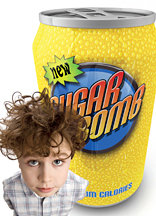 |
 |
|
|
Health Articles:
Alternative and General Health
Musculoskeletal Health
Nutrition and Herbs
Pediatric Health
Senior Health
Sports & Fitness
Women's Health
Ask A Doctor (Forum)
|
By Editorial Staff You've seen them on TV and in your supermarket aisle: superheroes and cartoon characters touting everything from sodas to sugar-laden cereals and snack chips. Batman, SpongeBob SquarePants and other characters have a willing consumer audience in our nation's children, to the tune of $1.6 billion a year, according to a recent report released by no less than the U.S. Federal Trade Commission. The report, Marketing Food to Children and Adolescents: A Review of Industry Expenditures, Activities, and Self-Regulation, found that advertising food products to children is all about integrated ad campaigns that combine traditional media, such as television, with packaging, in-store advertising, sweepstakes and the Internet. What this essentially means is that every time your child asks for a food item they saw advertised on TV, sends in a proof of purchase or logs on to the Internet to collect points to win prizes distributed by the food manufacturers, they are getting the message that eating these nutritionally deficient foods is actually a good thing. The executive summary of the report provided one such example of this sort of dangerous "cross-promotional" marketing: "Cross-promotions were widespread in 2006, tying foods and beverages in all of the covered categories to about 80 movies, television shows, and animated characters that appeal primarily to youth. Superman Returns and Pirates of the Caribbean were prominent that year - promoting QSR [quick-service restaurants] children's meals, frozen waffles, fruit and fruit snacks, breakfast cereals, popcorn, lunch kits, candy, carbonated and noncarbonated drinks, pasta, snack chips, and milk. Superman and the Pirates characters appeared in ads on television, in movie theaters, on the Internet, and on packaging and in-store displays. Companies created special limited-edition snacks, cereals, frozen waffles and candies based on the movies. Children or adolescents could go online to play 'advergames' related to the characters and their stories and to enter contests or sweepstakes using special codes obtained from food packages or beverage containers. Prizes ranged from video games to trips to Disney parks to a $1,000,000 reward for the 'capture' of Superman villain, Lex Luthor. Related premiums included skull-shaped bowls, bandanas, strobe-light key chains, movie posters, outdoor flying toys, Superman action figures, activity books, and digital downloads."
In terms of where the money is spent, the report noted, "Television advertising still dominates the landscape of marketing techniques used to promote foods and beverages to youth; companies reported spending $745 million, or 46% of all reported youth marketing expenditures, on this medium. More than 50% of the television advertising was directed to children under 12, with breakfast cereals and restaurant food accounting for more than half of that advertising. Carbonated beverages and restaurant food dominated adolescent-directed television advertising. All told, traditional 'measured media' (television, radio and print) accounted for $853 million, or 53% of the reported youth-directed marketing expenditures." "More and more, we see advertising for kids to get them hooked on high-fat, high-sugar, high-salt diets," said Sen. Tom Harkin (D-Iowa), who commissioned the study in 2005. "Something had to be done. We weren't getting honest information from companies." There you have it: the ugly truth about the extent companies go to in order to entice kids to eat less-than-healthy food. To learn more, access the full study at www.ftc.gov/opa/2008/07/foodmkting.shtm.  |
